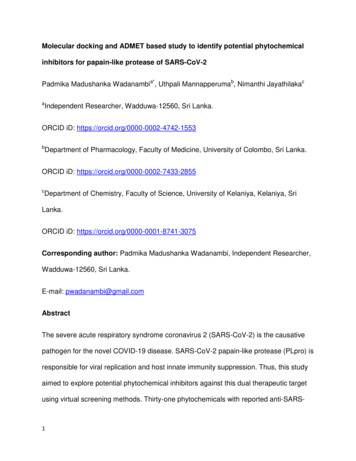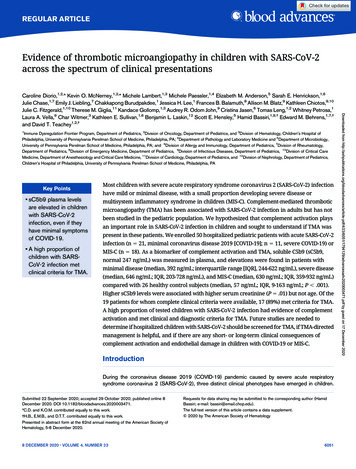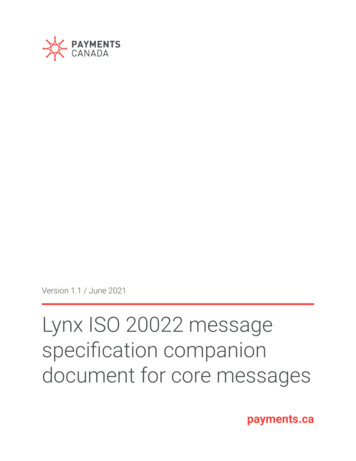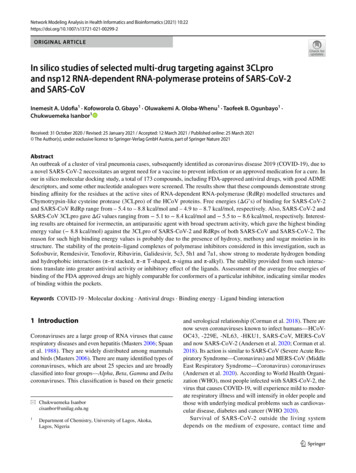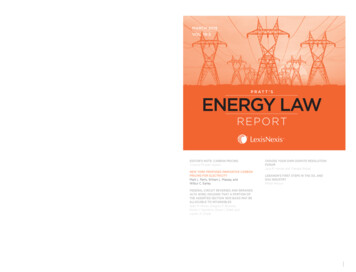
Transcription
March 2019VOL. 19-3PRATT’S Energy Law ReportP RA T T ’ sEnergy LawRepo rtEDITOR’S NOTE: CARBON PRICINGVictoria prussen SpearsNEW YORK PROPOSES INNOVATIVE CARBONPRICING FOR ELECTRICITYMark L. perlis, William L. Massey, andWilbur C. earleymarch 2019FEDERAL CIRCUIT REVERSES AND REMANDSALTA WIND, HOLDING THAT A PORTION OFTHE ASSERTED SECTION 1603 BASIS MAY BEALLOCABLE TO INTANGIBLESSean M. Moran, Gregory p. Broome,Nicole V. Gambino, Stuart I. odell, andLauren A. ChaseCHOOSE YOUR OWN DISPUTE RESOLUTIONFORUMJulia M. Haines and theresa WanatLEBANON’S FIRST STEPS IN THE OIL ANDGAS INDUSTRYMehdi Harounvol. 19-3
Pratt’s Energy Law ReportVOLUME 19NUMBER 3MARCH 2019Editor’s Note: Carbon PricingVictoria Prussen Spears67New York Proposes Innovative Carbon Pricing for ElectricityMark L. Perlis, William L. Massey, and Wilbur C. Earley69Federal Circuit Reverses and Remands Alta Wind, Holding Thata Portion of the Asserted Section 1603 Basis May Be Allocableto IntangiblesSean M. Moran, Gregory P. Broome, Nicole V. Gambino, Stuart I. Odell,and Lauren A. Chase73Choose Your Own Dispute Resolution ForumJulia M. Haines and Theresa Wanat79Lebanon’s First Steps in the Oil and Gas IndustryMehdi Haroun89
QUESTIONS ABOUT THIS PUBLICATION?For questions about the Editorial Content appearing in these volumes or reprint permission,please email:Jacqueline M. Morris at . (908) 673-1528Email: . jacqueline.m.morris@lexisnexis.comOutside the United States and Canada, please call . . . . . . . . . . . . . . . (973) 820-2000For assistance with replacement pages, shipments, billing or other customer service matters,please call:Customer Services Department at . . . . . . . . . . . . . . . . . . . . . . . . . . (800) 833-9844Outside the United States and Canada, please call . . . . . . . . . . . . . . . (518) 487-3385Fax Number . . . . . . . . . . . . . . . . . . . . . . . . . . . . . . . . . . . . . . . . (800) 828-8341Customer Service Website . . . . . . . . . . . . . . . . . . . http://www.lexisnexis.com/custserv/For information on other Matthew Bender publications, please callYour account manager or . . . . . . . . . . . . . . . . . . . . . . . . . . . . . . .Outside the United States and Canada, please call . . . . . . . . . . . . . . . .(800) 223-1940(937) 247-0293ISBN: 978-1-6328-0836-3 (print)ISBN: 978-1-6328-0837-0 (ebook)ISSN: 2374-3395 (print)ISSN: 2374-3409 (online)Cite this publication as:[author name], [article title], [vol. no.] PRATT’S ENERGY LAW REPORT [page number](LexisNexis A.S. Pratt);Ian Coles, Rare Earth Elements: Deep Sea Mining and the Law of the Sea, 14 PRATT’S ENERGYLAW REPORT 4 (LexisNexis A.S. Pratt)This publication is designed to provide authoritative information in regard to the subject matter covered. Itis sold with the understanding that the publisher is not engaged in rendering legal, accounting, or otherprofessional services. If legal advice or other expert assistance is required, the services of a competentprofessional should be sought.LexisNexis and the Knowledge Burst logo are registered trademarks of RELX Inc. Matthew Bender, theMatthew Bender Flame Design, and A.S. Pratt are registered trademarks of Matthew Bender Properties Inc.Copyright 2019 Matthew Bender & Company, Inc., a member of LexisNexis. All Rights Reserved.No copyright is claimed by LexisNexis or Matthew Bender & Company, Inc., in the text of statutes,regulations, and excerpts from court opinions quoted within this work. Permission to copy material may belicensed for a fee from the Copyright Clearance Center, 222 Rosewood Drive, Danvers, Mass. 01923,telephone (978) 750-8400.Editorial Office230 Park Ave., 7th Floor, New York, NY 10169 (800) 543-6862www.lexisnexis.com(2019–Pub.1898)
Editor-in-Chief, Editor & Board ofEditorsEDITOR-IN-CHIEFSTEVEN A. MEYEROWITZPresident, Meyerowitz Communications Inc.EDITORVICTORIA PRUSSEN SPEARSSenior Vice President, Meyerowitz Communications Inc.BOARD OF EDITORSSAMUEL B. BOXERMANPartner, Sidley Austin LLPANDREW CALDERPartner, Kirkland & Ellis LLPM. SETH GINTHERPartner, Hirschler Fleischer, P.C.STEPHEN J. HUMESPartner, Holland & Knight LLPR. TODD JOHNSONPartner, Jones DayBARCLAY NICHOLSONPartner, Norton Rose FulbrightBRADLEY A. WALKERCounsel, Buchanan Ingersoll & Rooney PCELAINE M. WALSHPartner, Baker Botts L.L.P.SEAN T. WHEELERPartner, Latham & Watkins LLPHydraulic Fracturing DevelopmentsERIC ROTHENBERGPartner, O’Melveny & Myers LLPiii
Pratt’s Energy Law Report is published 10 times a year by Matthew Bender & Company, Inc.Periodicals Postage Paid at Washington, D.C., and at additional mailing offices. Copyright 2019Reed Elsevier Properties SA, used under license by Matthew Bender & Company, Inc. No partof this journal may be reproduced in any form—by microfilm, xerography, or otherwise—orincorporated into any information retrieval system without the written permission of thecopyright owner. For customer support, please contact LexisNexis Matthew Bender, 1275Broadway, Albany, NY 12204 or e-mail Customer.Support@lexisnexis.com. Direct any editorialinquires and send any material for publication to Steven A. Meyerowitz, Editor-in-Chief,Meyerowitz Communications Inc., 26910 Grand Central Parkway Suite 18R, Floral Park, NewYork 11005, smeyerowitz@meyerowitzcommunications.com, 646.539.8300. Material for publication is welcomed—articles, decisions, or other items of interest to lawyers and law firms,in-house energy counsel, government lawyers, senior business executives, and anyone interestedin energy-related environmental preservation, the laws governing cutting-edge alternative energytechnologies, and legal developments affecting traditional and new energy providers. Thispublication is designed to be accurate and authoritative, but neither the publisher nor the authorsare rendering legal, accounting, or other professional services in this publication. If legal or otherexpert advice is desired, retain the services of an appropriate professional. The articles andcolumns reflect only the present considerations and views of the authors and do not necessarilyreflect those of the firms or organizations with which they are affiliated, any of the former orpresent clients of the authors or their firms or organizations, or the editors or publisher.POSTMASTER: Send address changes to Pratt’s Energy Law Report, LexisNexis MatthewBender, 121 Chanlon Road, North Building, New Providence, NJ 07974.iv
New York Proposes Innovative Carbon Pricingfor ElectricityBy Mark L. Perlis, William L. Massey, and Wilbur C. Earley*In a singular proposal, acting without any state or congressional mandate,but with the support of State regulatory agencies, the New York Independent System Operator (“NYISO”) proposes to require carbon pricing for allpower sold in New York State through the NYISO wholesale electricitymarket. The authors of this article discuss the proposal and the relatedregulatory issues.Carbon pricing is seen by many as an effective means of reducing carbondioxide (“CO2”) emissions from electricity generation. California and severalEastern states have enacted “cap and trade” emission allowance programs, whichhave forced generators in those states to pay a price for their CO2emissions.With the Obama Administration’s Clean Power Plan not being implemented,there is currently no federal policy in place that would result in carbon pricingfor electricity. In a singular proposal, acting without any state or congressionalmandate, but with the support of State regulatory agencies, the New YorkIndependent System Operator (“NYISO”) proposes to require carbon pricingfor all power sold in New York State through the NYISO wholesale electricitymarket. For the first time, the Federal Energy Regulatory Commission(“FERC”) will be called upon to decide whether and how carbon pricing maybe incorporated into wholesale electricity market tariffs solely under theauthority of the Federal Power Act.The NYISO carbon pricing proposal1 must be fully developed and vettedthrough a stakeholder process that could take one to two years to reachconsensus on a tariff amendment that would be submitted to FERC for reviewand approval. This stakeholder process and the subsequent FERC proceedingwill grapple with complex issues of electricity market design and noveljurisdictional and policy issues. The outcome of this process could lead to a*Mark L. Perlis (mperlis@cov.com), of counsel at Covington & Burling LLP, is an energyand environmental attorney with a broad-based federal regulatory and litigation practiceencompassing all aspects of the electric utility industry. William L. Massey (wmassey@cov.com),senior counsel at the firm who served as a Commissioner at the Federal Energy RegulatoryCommission, has a broad-based energy regulatory and government affairs practice. Wilbur C.Earley (bearley@cov.com), a non-lawyer senior advisor at the firm, provides analysis and adviceon a wide range of federal and state energy regulatory 72fe5180-ef24-f700-87e5-fb6f300fb82c.69
PRATT ’S ENERGY LAW REPORTpush for the adoption of carbon pricing in other FERC-regulated organizedregional electricity markets throughout the nation.THE NYISO CARBON PRICING PROPOSALThe NYISO proposes to fix the price of carbon emissions from electricitygeneration at the “social cost of carbon,” which is a measure developed byfederal agencies and endorsed by New York State agencies. The social cost ofcarbon is more than triple the recent market price of CO2 allowances in statecap and trade programs.The NYISO operates auction-based wholesale electricity markets, whichestablish market-clearing prices that all suppliers receive and all wholesalepurchasers pay. Suppliers submit bids to the NYISO to provide quantities ofelectricity at different prices and the highest-priced offer that is needed andaccepted to meet electricity demand in each hour sets the single market-clearingprice for that hour. Under competitive market conditions, market clearingprices are determined by the marginal costs of production (i.e., generators’ fuelcosts) of the last increment of supply that clears the market. Today, suppliers’bids include emission allowance costs, but these are a fraction of the social costof carbon. The NYISO’s carbon pricing proposal would require that allsuppliers’ bids include the social cost of carbon of all of the CO2 emissions fromin-state generation resources that would supply the quantity of power the bidsrequire.To the extent carbon-emitting resources set the market-clearing electricityprice, which they are likely to do for much of the foreseeable future in NewYork State, electricity prices paid by retail utilities and energy service providerswill rise substantially. Some experts predict NYISO wholesale electricity pricescould increase by between 50 and 75 percent, although much of the priceincrease is proposed to be rebated to consumers. Zero-carbon resources, such aswind, solar, and nuclear facilities, will receive the full market clearing price.Carbon-emitting resources, such as coal and natural gas facilities, will have theircarbon costs deducted from their market revenues. The aggregate difference(referred to as “Carbon Residuals”) between amounts the NYISO collects fromall wholesale purchasers and amounts paid to suppliers (reflecting the carboncharge to suppliers) would be rebated in some manner to retail customers.JURISDICTIONAL AND MARKET DESIGN ISSUESDoes the Federal Power Act Authorize Carbon Pricing?In the absence of a state or other federal law that imposes carbon costs onelectricity generators, FERC and the courts will need to decide whether, actingsolely under the authority of the Federal Power Act, FERC may approve andestablish the imposition of a carbon price adder on all electricity sold under an70
NEW YORK PROPOSES INNOVATIVE CARBON PRICINGFORELECTRICITYISO tariff. Some may challenge the carbon price adder as a “tax” that must beenacted by Congress or as an environmental measure beyond the jurisdiction ofan economic regulator such as FERC. Others will defend the proposal as a “justand reasonable” measure necessary to establish economically efficient andnon-discriminatory wholesale electricity markets. Conversely, it may be arguedthat the absence of a carbon price is a “practice affecting wholesale electricityrates” that is discriminatory and unjust and unreasonable, which must becorrected by FERC under the Federal Power Act.Who Sets the Carbon Price?The NYISO proposes that the New York Public Service Commission wouldset the social cost of carbon, relying in part on calculations of a federalinter-agency working group that has since been disbanded by executive order.2Will FERC allow the authority to establish a component of a wholesaleelectricity rate to be delegated to a state agency? Will the social cost of carbonbe adjusted over time and, if so, by whom and using what standards?Should Burner Tip or Upstream Carbon Emissions be Priced?The NYISO proposes that the carbon price be imposed only on CO2emissions from combustion at the generating facility, but others may proposethat the social cost of carbon should reflect upstream carbon emissions(including methane) associated with fuel extraction and transportation.Who Determines Exemptions from the Carbon Price?The NYISO proposes to let state rules determine whether certain types of“clean energy” suppliers could be exempt from carbon pricing.How Will Carbon Prices be Rebated to Retail Consumers?The NYISO proposes to allocate any Carbon Residuals back to load-servingentities, which it intends would be rebated to retail customers. However,perhaps because of perceived jurisdictional limitations, the NYISO has notproposed a method for how load serving entities would rebate those CarbonResiduals to retail customers. It is uncertain whether the Federal Power Actpermits the NYISO to include in its FERC-approved tariff specific retail rebaterequirements and retail customer allocation methods for effectuating rebates.How to Treat Electricity Imports to and Exports from New York State?The NYISO proposes to exclude imported electricity from carbon chargesand to rebate carbon charges for electricity exports, while energy-independence-economic-growth/.71
PRATT ’S ENERGY LAW REPORTpotential drawbacks of applying the carbon price only to in-state generationsupplying in-state consumption. Extending carbon pricing to imports mightraise jurisdictional issues, carbon attribution issues, and complicate schedulingand bidding processes. Nonetheless, stakeholders might ask why, as a policymatter, imports should be excluded from complying with the bidding requirements for electricity that will be consumed in New York State.How Should Carbon Pricing Take Account of Other State ProgramsThat Incentivize Low Carbon Resources?The NYISO proposes to allow generators to credit against their carbon priceamounts paid for CO2 emission allowances under the Regional GreenhouseGas Initiative. The NYISO proposes no adjustment to amounts received byrenewable generators that receive Renewable Energy Credits (“RECs”) under aState program. Others have advocated that receipt of RECs and the full marketclearing price will provide “double counting” of renewables’ zero carbonattributes.There will be many more design issues to be faced in incorporating carbonpricing into the complex NYISO tariff rules governing, bidding, scheduling,price-setting, out-of-market dispatch, and the capacity market. Although theNYISO’s carbon pricing proposal is relatively simple in concept, it may provedevilish in the details.72
rgy Law Repo R t. Pratt's Energy Law Report VOLUME 19 NUMBER 3 MARCH 2019 Editor's Note: Carbon Pricing Victoria Prussen Spears 67 New York Proposes Innovative Carbon Pricing for Electricity Mark L. Perlis, William L. Massey, and Wilbur C. Earley 69 Federal Circuit Reverses and Remands Alta Wind, Holding That a Portion of the Asserted Section 1603 Basis May Be Allocable to Intangibles Sean .


